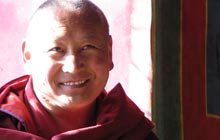 Foundation of the Gelug Sect
Foundation of the Gelug Sect
Tsong Khapa (1357-1419) founded Ganden monastery in 1409. A graduate of the austere Karmapa order, his doctrine emphasized monastic discipline. This attitude was echoed by his reinforcement of the primacy of sutras – the original teachings of Buddha – over the tantras – later mystical teachings. So popular was his movement that new monasteries were soon opened at Sera, Drepung & Tashilhunpo, and the sect took on the name of Gelug or "Virtuous Ones".
Dalai Lama
During the tenure of the third Gelugpa leader, Sonam Gyatso (1543-1588), a Mongolian force invaded Tibet. When the Mongol leader, the Altan Khan, met Sonam Gyatso he was so awed as to immediately convert to Buddhism. As part of the ensuing priest patron relationship, the Khan conferred the title Dalai Lama or "Oceanic Teacher" upon Sonam Gyatso, who retroactively applied it to his two predecessors, thereby becoming the Third Dalai Lama.
In 1640, when civil unrest again arose in Tibet, the Fifth Dalai Lama, Ngawang Lobsang Gyatso (1617-1682) applied for assistance from his associates, the Mongols. It was after their subsequent pacification of the nation, that the Mongols invested him with complete political control. The Fifth Dalai Lama thereby became the spiritual and temporal leader of Tibet. So capable was he, in both temporal and spiritual realms, that this Dalai Lama is often referred to as the "Great Fifth".
The current Dalai Lama, Tenzin Gyatso, (1935 – ) is the Fourteenth one. Like those before him, he is held to be the reincarnation of the Bodhisattva of Compassion, Avalokiteshvara. The concept of reincarnation is fundamental to the continued lineage of the Dalai Lama. This is maintained by the discovery of a young child born soon after the death of a previous Dalai Lama. It is believed that the life-spirit of the deceased transfers to the newly found child, who takes on the pre-ordained mantle of the Dalai Lama.
Panchen Lama
In the 17th century, the Fifth Dalai Lama declared his tutor, the abbot of the Tashilhunpo monastery, Panchen Lama or the "Great Scholar" Lama. This abbot, by retroactively applying the title to the three abbots preceding him, thereby became the Fourth Panchen Lama. As such, he was believed to be the reincarnation of Amitabha, the Buddha of Infinite Light. Like the lineage of the Dalai Lama, the Panchen Lama's lineage is preserved through a process of reincarnation. The current Panchen Lama is the Eleventh in line.
For centuries, the Dalai Lamas and Panchen Lamas initiated one another as divine leaders, the older one customarily serving as tutor to the younger one. However, with the rise in influence of the Panchen Lama at certain times he came to be seen as a political rival rather than a partner of the Dalai Lama.
 Every Tibetan family struggled to afford the honor of sending a family member to a monastery. This indeed was no small sacrifice since the continuing upkeep of the monks was the responsibility of their respective families. To give some idea of the popularity of this religious mission, in the early twentieth century approximately one fifth of all Tibetan men were monks. Though there were also nunneries, their numbers were not as large.
Every Tibetan family struggled to afford the honor of sending a family member to a monastery. This indeed was no small sacrifice since the continuing upkeep of the monks was the responsibility of their respective families. To give some idea of the popularity of this religious mission, in the early twentieth century approximately one fifth of all Tibetan men were monks. Though there were also nunneries, their numbers were not as large.
When a young boy, aged six or seven, was sent off to the monastery, it was not certain that his occupation would be scholastic. Depending on his strengths, the young initiate might be assigned to become a soldier, cook or clerk within the monastic administration. Only an intellectual and spiritual elite was privileged to participate in the 25 year scholastic apprenticeship necessary to graduate to geshe examinations.
Daily Routine
The monastery begins its day at 5am when all the monks assemble at the prayer hall for morning worship. Two hours later they return to their respective houses to enjoy a breakfast of Tibetan bread and butter tea (a mixture of black tea, milk, butter and salt). The rest of their morning until lunch break at 12.30pm is taken up with monastic classes. In the afternoon, monks attend individual lessons given in their separate houses. After a dinner of soup and rice at 6pm, they attend Buddhist scripture classes until 9pm. Senior monks will attend philosophical debates instead.
Primary Education
After establishing a foundation in reading, writing and arithmetic, progressively graded classes provide explanations of elemental Buddhist Teachings or Sutras, as well as teaching in various techniques of recitation. These classes are graded and will occupy the student until he is sixteen to eighteen years of age.
When deemed ready, the student will start to take part in debates, a crucial discipline. Supervised by seniors, the monks divide into small groups and take turns asking questions and debating various topics. Debating skills are highly valued as instruments to sharpen the mind as well as for preparing monks to answer questions from students in the future.
Having mastered rhetoric and debate, the monk must sit exams in logic. Once this is done, he is ready to embark on a more advanced course of study.
Advanced Study
This is comprised of the following six elements:
1) Perfection of Wisdom ( Prajnya parramita )
Based on "The Jewel of Realization", a 4th century text, the pupil spends 6 years considering such subjects as the nature of nirvana, deep levels of meditation and the wish for enlightenment.
2) The Middle Way ( Madhyamika )
Spending four years studying a collection of texts dating from the 3rd to the 7th century, the student goes deeper into the analysis of the quality of emptiness and the ephemeral properties of such emotions as joy, illness and jealousy.
3) Higher Knowledge ( Abhidharma )
Written by Master Vasubandhu in 350CE, "The Treasure House of Higher Knoweldge" is the text that leads students to investigate the role and creation of karma, the nature of bardo (the intermediate state between death and rebirth), the constituents of time and space and the destruction of the world. These themes demand two years of monastic study.
4) Vowed Morality ( Vinaya )
A further two years are spent considering the nature of monastic vows, both in terms of their benefits and the attendant loss of freedom.
5) Buddhist Logic ( Pramana )
This is a study that occurs in periodic intervals throughout the 15 years of advanced study. It examines logical reasoning per se as well as the validity of many arguments at the root of the Buddhist faith.
6) The Steps to Buddhahood (Lam Rim)
Written by the founder of the Gelug sect, this 15th century text, prepares the student for the ritualistic meditation required along the path to enlightenment.
Having finished this study, the monk will qualify as a medium scholar geshe . After a further 7 years of study of degree text, and passing its associate exams, he will qualify as a highly learned scholar, or top-level geshe . In all, by this time, he will have spent 32 years in study.
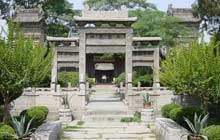 The History of the Silk and Fur Roads
The History of the Silk and Fur Roads
The incursions of the Xiongnu, a savage Turkic tribe that regularly pillaged the towns on China’s northern border, prompted the Han Emperor Wudi (r. 140-86BC) to seek Western allies for a joint attack. For this military reconnaissance mission he sent out one hundred men, led by Zhang Qian, who took thirteen years to report back with tales of glittering western cities and alien cultures. As soon as he did though, Zhang Qian was sent back in charge of a still larger party equipped with ten thousand sheep, gold, satin and silk.
This second journey, China’s first substantial contact with the Central Asian civilizations, opened up caravan routes. The route that passed south of the Tianshan mountains, used primarily for the export of Chinese goods, came to be known to Europeans as Silk Road. However, another route, which passed north of the Tianshan mountains, was known in China as the Fur Road, and it was along this passage that new religions, ideas and goods were imported into China.
During the spectacular military, cultural and financial successes of the Tang dynasty (618-907) many merchants from Persia, Arabia and Central Asia were attracted to China’s capital, Changan, in search of profit. They brought their religions and fashions with them.
The Great Mosque and Muslim Quarter
As foreign communities grew in size, they introduced their own customs and facilities. The 50,000 strong Muslim community that lives and works today in Xi’an traces its history to those Middle Eastern merchants who, after travelling the Fur Road, settled down here. Then, as now, the Muslim community perpetuated their culture by operating mosques and schools. So it is that the Great Mosque was originally constructed in the year 742. Today the Muslim community, which supports ten or so mosques, runs its own primary school, foods shops and restaurants. For over 1300 years, they have been an integral part of Xi’an’s colourful daily life.
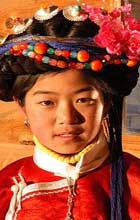 History
History
The Naxi are one of China 's 56 recognized ethnicities, and although they have lived on the edge of the Chinese empire for centuries they have preserved many remarkable features of their culture. Some say the Naxi are descended from a group of people known in Chinese historical texts as the Qiang, whose homeland included parts of the Tibetan Plateau as well as the western areas of Sichuan and Yunnan . The situation is complicated as there is still a recognized Qiang ethnic minority in Sichuan . All this really goes to show is that the Chinese attempt to provide categorical definitions of who is and who is not a minority ethnicity, and where the lines between different ethnicities can be drawn, is a thankless and sometimes impossibly misleading task. In the early history of Naxi Lijiang, the area was pressed on all sides – to the south was the strong and aggressively expansionist non-Chinese state known as Nanzhao which was run by some combination of the Bai and Yi peoples; west of course lay the flourishing Tibetan empire at one of the strongest periods of its existence; while to the north-east were another group of Yi people, who also spent much of their spare time raiding their neighbors. While contacts with the Chinese proper have waxed and waned, the area only became formally integrated into the Chinese empire in the eighteenth century. For this reason perhaps there are a number of remarkable features of Naxi culture which have survived intact down to our day, they include language (especially the curious written forms), religious practices, music, and a reputation as being the sort of matriarchy that is somehow heaven for men.
The Naxi language belongs, appropriately enough considering that it is sandwiched between China and Tibet , to the Lolo-Burmese group. This group is a subset of a subset of the large Sino-Tibetan family which naturally includes Chinese and Tibetan. The Naxi also have their own written language comprising around 1500 pictographs. Like Chinese it is traditionally written top to bottom, but unlike Chinese it reads from left to right. It is not known when the writing first came into use but some estimates put it back at least a thousand years. It is not only, as one might surmise, limited to agricultural or trade uses – but has long been an integral part of the religious ceremonies conducted by the dongba, or local priests (and for this reason is known in Chinese as 'dongba writing' – although there is a newer modified form called 'geba writing' which is more a syllabary than a collection of pictographs, it also incorporates a Chinese influence).
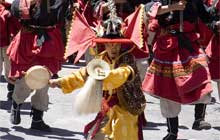 Religion
Religion
Religion in the area is quite complex. As you would expect from a culture that borders so many others there is not a single faith or belief to the exclusion of others. Underneath many beliefs is an unsurprising animism, and then there are forms of Buddhism, of Taoism, of Tibetan Bon, and in recent times some Christianity. Most people are connected with what is called Dongba religion (once again named after the priests). The cultural anthropologist Emily Chao provides a succinct description of this and a related form of traditional Naxi religious activity:
The Naxi had two types of ritual practitioners who were often referred to as shamans: the dongba, often translated as "priest," and the sanba, translated as "shaman." Dongbas differed from sambas in that they acquired their skills through apprenticeships that required learning pictographic texts to be used in structured rituals. Dongbas usually inherited their professions and were always male. The role of sanba, open to both men and women, was not learned or chosen but resulted from a traumatic illness during which a channel communication with a spirit or god opened up. Aside from practicing purification and propitiation of the gods, sanbas do not follow standard or predictable sequences in their rituals. Neither the role of dongba nor that of sanba was prestigious, and it was often taken on by poor farmers seeking to supplement their livelihoods.
Traditionally shamans in the area wore cloth turbans, wielded swords or beat drums, and while doing so would chant their shamanic rituals in a whispered voice.
While the situation with religion is quite complex, it's the opposite with music.
Music
We defy you to find a Naxi person who does not enjoy singing or dancing. Since the 1980s traditional Naxi music has been increasingly recognised as an art form well worth cultivating and preserving. The comparative political relaxation of the 1980s made possible the resumption of minority cultural practices that had formerly been either frowned upon; discouraged as being backward and superstitious; or just outright banned. It was in this period that the famous Naxi orchestra initially began playing locally. Domestic and foreign tourists who came through in that decade were entranced, especially as the orchestra made a conscious effort to not 'modernise' their music, and the orchestra garnered a nation-wide reputation. This fame spread and in 1995 they undertook their first foreign concert tour, to critical acclaim. The orchestra comprises percussion, flutes, lutes, and pipes. While much of the music was borrowed from the Chinese several centuries ago the Naxi have made it their own, incorporating their own instruments and musical flourishes.
Matriarchy
Finally, a word about the sexes. Naxi men are well known for their laziness. Apparently, there are three ambitions for a Naxi man:
• Build a house
• Marry and have a son
• Bask in the sun
When they are not otherwise engaged, Naxi men enjoy hunting, raising birds, playing Naxi music and practicing calligraphy, a list that clearly shows a mix of traditional concerns (hunting) with Chinese influences (calligraphy, or pretensions to being a scholar). Naxi men use hawks in their hunting and previously they used to sit on the bridge parading their hunting hawks and watching the women walk by. Despite their much-vaunted reputation as a matriarchal society the truth is somewhat different. As a general rule young boys are allowed to be as naughty as they please, while girls help their mothers with the chores as soon as they are able. Furthermore, girls marry out, and kinship is reckoned from the father's side – making the whole social edifice appear a very male-friendly (if not wholly male-invented) form of matriarchy. The association of the Naxi with matriarchy seems to be an unfortunate consequence of another closely related ethnicity known in Chinese as the Mosuo, who do in fact practice matrilineal descent. The Musuo, who are based to the north-west of Lijiang, are classified by the Chinese authorities as belonging to the Naxi ethnicity, a categorization that the Naxi usually strenuously oppose.
One small piece of history – look for a missing index finger on the right hand of some elderly men. Apparently this indicates that they had no wish to be conscripted to fight for the Kuomintang against the Japanese in the late 1930s and early 1940s. The fight against the Japanese was another interesting chapter in the long-running story of a route which joined Lijiang with Tibet , a route which came to be known as the southern branch of the Tea and Horse Route .
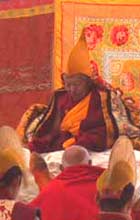 The three Gelug monasteries of Sera, Drepung and Ganden were known collectively as the "Pillars of the State". As such there was naturally political rivalry between them. This can even be seen in the naming of this monastery. Sera, meaning "merciful hail" is a challenge to Drepung monastery, whose name means "rice heap" in the sense that hail damages rice. This rebellious monastery, some of whose monks were famed for their soldiery last challenged power in 1947. In the course of this failed coup, they even made an attempt on the then Regent's life.
The three Gelug monasteries of Sera, Drepung and Ganden were known collectively as the "Pillars of the State". As such there was naturally political rivalry between them. This can even be seen in the naming of this monastery. Sera, meaning "merciful hail" is a challenge to Drepung monastery, whose name means "rice heap" in the sense that hail damages rice. This rebellious monastery, some of whose monks were famed for their soldiery last challenged power in 1947. In the course of this failed coup, they even made an attempt on the then Regent's life.
Founded in 1419, at its height, Sera monastery was residence to more than 5,000 monks and five monastic colleges. Although much less active now, with only several hundred monks currently in residence, one of the most interesting times to visit the monastery is in the afternoon when monks, after finishing their morning scripture classes, can be seen debating in the courtyard.
The monastery is made up of a tsokchen (Great Hall), three tratsangs (colleges that offer specialised studies) and thirty khangtsens (residential compounds with chapels reserved for monks coming from different areas of Tibet).
The tsokchen is Sera's largest building and the administrative center of the monastery. Built in 1710, the central assembly hall houses a statue of Sakya Yeshe, the founder of Sera, flanked by sculptures of the Fifth and Thirteenth Dalai Lamas . To the rear of the central assembly hall are four floors, each filled with chapels dedicated to various gods as well as the monks' quarters.
Sera Me Tratsang, built in 1419 by Sakya Yeshe, specializes in teaching novices the fundamental precepts of Buddhism. Its assembly hall is famed for a copper sculpture of Sakyamuni (Historical Buddha) as well as for murals adorning the numerous chapels. Ngagpa Tratsang was also built in 1419 by Sakya Yeshe and is the monastery's Tantric college. Sera Je Tratsang is the monastery's largest college and was responsible for the instruction of itinerant monks from outside the region. The famous debating courtyard is located with this tratsang.
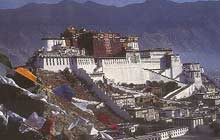 The impetus for the construction of a palace on Lhasa's Red Hill came from King Songtsen Gampo (608-650) who commissioned it. This was smaller than its 5-square-mile (13-square-km) successor, which was named the Potala ("Pure Land," or "High Heavenly Realm"), after Mount Potalaka in India, the abode of Tibet's patron saint, the Bodhisattva Avalokiteshvara of whom the Dalai Lama is the incarnation.
The impetus for the construction of a palace on Lhasa's Red Hill came from King Songtsen Gampo (608-650) who commissioned it. This was smaller than its 5-square-mile (13-square-km) successor, which was named the Potala ("Pure Land," or "High Heavenly Realm"), after Mount Potalaka in India, the abode of Tibet's patron saint, the Bodhisattva Avalokiteshvara of whom the Dalai Lama is the incarnation.
In 1645, the Fifth Dalai Lama (1645-1693), feeling confined at Drepung Monastery, ordered the construction of a new structure that would accommodate his new role as both a religious and political leader. The Potala was then built as the imposing and self-confident expression of the new theocracy. After the ascension of the Seventh Dalai Lama, who established a summer palace at the Norbulingka, the Potala was used predominantly during winter. Despite this, it always remained the emblematic focus of the Dalai Lama's government. Owing to the security afforded by its elevated position, until the mid-18th century it also served as a military fortress.
The palace contains over a 1000 rooms and is divided into two main sections. The first section, known as the upper "Red Palace" served a religious function, housing the living quarters of the Dalai Lama, the gold-plated tombs of eight previous Dalai Lamas, a library containing religious scriptures and numerous temples, chapels and shrines containing thousands of Buddhist sculptures. The second main section, known as the "White Palace" served a political function, incorporating the offices and living quarters of the Tibetan government, a seminary to train future government officials as well as a printing press. Another minor building, known as the Yellow Building, housed giant thankas, which were hung across the south face of the palace during the last day of the second lunar month.
Directly below these ceremonial areas were quarters for the monks and servants along with two treasuries, one for the Dalai Lama and the other for lesser Lamas and Regents. Lower still lay granaries and storehouses filled with gifts from pilgrims as well as the ever-present yak butter needed to light the Potala's countless votive lamps. At the base of the Potala, carved into rock, were dungeons where prisoners were kept closely guarded.
Measuring 100 meters in height, 400 meters east to west and 350 meters north to south, the inward-sloping stone walls are between three and five meters thick. Copper was poured into the palace foundations, and it is said that so much earth was used in its construction that a lake was made from the pit that was created. When you contemplate the Potala, this massive, beautiful yet forbidding structure, it is evident that its construction was a gigantic undertaking, yet one that has bequeathed to the world one of its most unique architectural treasures.
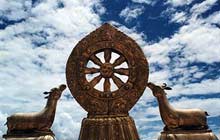 The Jokhang, or "House of the Lord," is the holiest site in Tibet and is the ultimate pilgrimage destination for Tibetan Buddhists. King Songtsen Gampo first built a temple here in the mid-7th century, but the structure that we see today is largely the result of reconstruction in the 17th century, commissioned by the Fifth Dalai Lama. The Jokhang houses the Jowo Buddha, a Buddhist sculpture brought as part of the dowry of the Chinese Princess Wencheng upon her arrival in Tibet. It is said that upon her husband, King Songtsen Gampo's death, the princess hid the sculpture in the temple. The miraculous survival of this ancient Buddhist sculpture makes it today one of Tibet's most revered images.
The Jokhang, or "House of the Lord," is the holiest site in Tibet and is the ultimate pilgrimage destination for Tibetan Buddhists. King Songtsen Gampo first built a temple here in the mid-7th century, but the structure that we see today is largely the result of reconstruction in the 17th century, commissioned by the Fifth Dalai Lama. The Jokhang houses the Jowo Buddha, a Buddhist sculpture brought as part of the dowry of the Chinese Princess Wencheng upon her arrival in Tibet. It is said that upon her husband, King Songtsen Gampo's death, the princess hid the sculpture in the temple. The miraculous survival of this ancient Buddhist sculpture makes it today one of Tibet's most revered images.
The Jokhang is built on what was formerly a lake. Several legends provide explanations for the selection of this unusual location. The most popular tells of how King Songtsen Gampo tossed a ring from his finger, swearing to build the temple wherever it fell. When the ring landed in the lake, a white stupa appeared magically and the Jokhang was constructed on this site. Another legend explains that Princess Bhrikuti of Nepal, on joining King Songtsen Gampo's court, perceived a great demoness in the Tibetan landscape. Having established that the demoness' heart lay beneath a small lake in Lhasa, she ordered the lake filled and the erection of the Jokhang Temple there.
Above the main entrance to the Jokhang is a golden, eight-spoked Dharma Wheel, flanked by two deer. The spokes of the wheel represent the Eight-fold Path (to enlightenment) and the deer serve as a reminder that Buddha gave his first sermon in a deer park. On any given day, one will be awed by the dozens of pilgrims bodily prostrating themselves before this entrance.
The walls of the first courtyard are lined with hundreds of votive lamps. This is the flickering doorway leading into one of Tibet's most intensely religious atmospheres. The first floor houses a series of chapels, each dedicated to a different deity, monk or king. Behind the numerous sculptures, the chapel walls are covered in vivid murals depicting relevant sutra and historical narratives. A circuitous path between the labyrinthine chapels eventually leads you to the inner sanctum, used daily for worship. At its centre, behind rows of cushions, stand larger than life size statues of Buddhas and Bodhisattvas.
Outside, above the temple's third story rooftops, are an agglomeration of pavilions, comprised of craftsmen's workshops and monks' living quarters. Here, you will glimpse monks debating in one of the numerous back courtyards or perceive their studying forms through the thin curtains of their quarters. Otherwise, looking out, you will enjoy spectacular views across the Barkhor, the pilgrimage route encircling the Jokhang Temple, and across the roofs of Lhasa towards the Potala Palace.
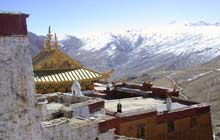 Prophesied by the historic Buddha approximately about 2,000 years before his birth, Tsongkhapa (1357-1419) was a child prodigy who went on to establish and inspire Tibet's most powerful monastic sect. Dissatisfied by the ill discipline – intellectual, religious and monastic – of contemporary orders, he reined his disciples and followers into a strict new order. The Gelug sect re-established the austerity of monastic life and emphasized the primacy of philosophical study within it. Ganden Monastery was founded near Lhasa in Tibet by Tsongkhapa in 1409 as the first and main Gelug monastery.
Prophesied by the historic Buddha approximately about 2,000 years before his birth, Tsongkhapa (1357-1419) was a child prodigy who went on to establish and inspire Tibet's most powerful monastic sect. Dissatisfied by the ill discipline – intellectual, religious and monastic – of contemporary orders, he reined his disciples and followers into a strict new order. The Gelug sect re-established the austerity of monastic life and emphasized the primacy of philosophical study within it. Ganden Monastery was founded near Lhasa in Tibet by Tsongkhapa in 1409 as the first and main Gelug monastery.
The enthusiastic zest with which the great Tsongkhapa viewed his endeavor can be sensed in his naming of this monastery. "Ganden" is the Tibetan name for the paradise of the Buddha of the Future. According to scriptures, the arrival of this Buddha will herald the end of the world's sufferings. This name therefore suggests the salutary wish that Ganden monastery would become a route to the world's salvation.
Tsongkhapa, as the first abbot of Ganden Monastery, was the appointed head of the Gelug sect. To this day, the abbot or Tripa of Ganden Monastery, rather than the Dalai Lama, leads this predominant sect. An interesting feature of this succession is that unlike the succession of Dalai Lama, which operates according to the principle of reincarnation, the position of Ganden Tripa is elective. As a result, the Ganden Tripa has traditionally been a strong candidate for the position of Regent within the Tibetan government at such times when the Dalai Lama was in his minority, absent or, as on occasion, deceased.
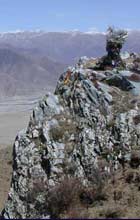
The three main sights of Ganden Monastery per se are the Serdung, which contains the golden tomb of Tsongkhapa, the Tsokchen Assembly Hall and the Ngam Cho Khang Chapel where Tsongkhapa traditionally taught his students.
The Ganden Lingkhor
A visit to Ganden Monastery is incomplete without walking its hour long pilgrimage route. The views over the Lhasa River Valley from this 4,500 meter high (~14,500 feet) vantage point are inspiring, their beauty paying rich tribute to Tsongkhapa's prudence in locating his monastery here. This walk will also introduce many aspects of a Tibetan pilgrimage route. Our path is signposted by a rich array of colourful prayer flags fluttering in the breeze. Either side, rock faces are rubbed with yak butter offerings and small shrines in rock fissures are filled with tsha-tshas , small religious offering tablets made of clay deposited by pilgrims. Some pilgrims prostrate at every step, others before holy emblems or as tradition demands; for example, at the sky burial site it is customary to roll over on the ground to rid oneself of sin.
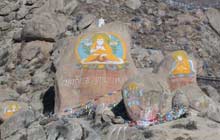 Jamyang Choje, a disciple of Tsongkhapa, founded Drepung Monastery in 1416. He is reputed to have been born to a wealthy family near the town of Samye and to have secured initial finances for the construction of the monastery from a wealthy childhood friend. Likewise, the immediate popularity of the monastery, which had some 2000 monks in residence within the first two years, is attributed to the support of wealthy family friends.
Jamyang Choje, a disciple of Tsongkhapa, founded Drepung Monastery in 1416. He is reputed to have been born to a wealthy family near the town of Samye and to have secured initial finances for the construction of the monastery from a wealthy childhood friend. Likewise, the immediate popularity of the monastery, which had some 2000 monks in residence within the first two years, is attributed to the support of wealthy family friends.
At its height, Drepung was the world's largest monastery, having over 10,000 monks in residence. In 1530, when the Second Dalai Lama made Ganden Palace his main residence, Drepung monastery became not only the primary residence of the Dalai Lama but also the political base for the Gelug monastic sect. As a result, the tombs of the Second to Fourth Dalai Lamas are at Drepung Monastery. From 1645, when the Fifth Dalai Lama established the Potala Palace as Tibet's political and spiritual headquarters, the bodies of later Dalai Lamas were entombed here instead.
At the time of Drepung's founding, seven tratsangs (or colleges) were instituted, each under the tutelage of one of Jamyang Choje's disciples. In the 18th century, however, the massive student body required the restructuring of the monastery into the current system of four colleges. Each tratsang had its own abbot, syllabus, dormitories, kitchens, etc., with Ngagpa specializing in esoteric teachings and the other three, Loseling, Gomang and Deyang, dedicated to esoteric disciplines. Of these, Loseling was the largest, at one time combining 23 khangtsen (or residences of study).
Drepung Monastery is of great historical importance not only in that it produced some of Tibet's most renowned spiritual leaders, but also in that it always enjoyed significant political influence. This was the case not only when the Dalai Lama ruled from the monastery itself but also afterwards, when the official residence was moved to the Potala Palace. For instance, the abbot of the Tshomchen wielded tremendous power within Lhasa's government.
While the monastery thankfully survived the Cultural Revolution relatively unscathed, more than half of its highest officials fled to India together with the Dalai Lama in 1959. A majority of the Drepung monks remaining in Tibet retired to secular life. As a result, there are now only about 600 monks in residence. Notwithstanding the paucity of its current monastic population, the continued preservation of Drepung's architectural structures make it one of Tibet's most important cultural legacies.
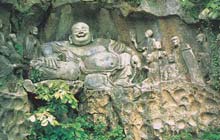 Lingyin Temple, or the Temple of Inspired Seclusion, was founded in 326 AD by the Indian monk, Hui Li. It quickly became a center of worship for the Chan (Zen) Buddist sect, and once served as home to more than three thousand monks. During its turbulent history the temple has been destroyed and then restored no less than sixteen times with the current structures dating to the late Qing dynasty (1644-1911).
Lingyin Temple, or the Temple of Inspired Seclusion, was founded in 326 AD by the Indian monk, Hui Li. It quickly became a center of worship for the Chan (Zen) Buddist sect, and once served as home to more than three thousand monks. During its turbulent history the temple has been destroyed and then restored no less than sixteen times with the current structures dating to the late Qing dynasty (1644-1911).
Before reaching the temple however, you will pass a series of rock carvings on the "Peak that Flew from Afar". This was named in honor of the Indian monk, Hui Li, who commented that the mountain looked exactly like one in India. Between the tenth and fourteenth centuries, this peak's rock surfaces were carved with over three hundred Buddhist statues. One of the most famous is that of the Laughing Buddha, known as the Maitreya or the Buddha of the Future. Dedicated to him is a couplet which reads,
"His belly is big enough to contain all intolerable things in the world;
His mouth is ever ready to laugh at all snobbish persons under heaven."
It is believed that if you rub the belly of this Buddha, he will be able to foretell your future and make your wishes come true.
Lingyin temple, like many Chinese temples, is constructed according to a basic pattern. Built on a north-south axis with the main entrance to the south, it is surrounded by a protective perimeter wall. The main entrance, secured by heavy gates, is guarded by sculptures of the Four Guardian Warriors-protectors of the temple.
Standing behind these is a short spirit wall – this prevents direct entry to evil spirits, which are said to travel in straight lines. Circumambulating it, you will find yourself in a courtyard on the far side of which stand several enormous bronze vessels. These continue to be used to burn either incense or paper offerings to the gods.
Behind them is the first temple pavilion, usually elevated from the courtyard by a short set of steps. In front of the main Buddha stands an altar piece hosting such objects as candle holders, incense burners and an offering plate containing fruit, money and even candy. At Lingyin Temple, the central statue is an eighteen foot high statue of Sakyamuni, or the Historical Buddha, made in the Tang dynasty (607-960). Carved out of twenty-four pieces of camphor wood, it is said to be one of the largest wooden Buddhas in the world.
Typically this representation of the Buddha includes a glass ball on his forehead representing the eye of wisdom, long earlobes which portend longevity, the thumb-middle finger gesture signifying strength and wisdom, a lotus pedestal associated with purity (since the flower emerges unstained from the mud), and the nimbus behind his head which signals brightness. On this nimbus are carved the "seven ancient Buddhas" who symbolize the seven gems (gold, silver, glaze, glass, coral, agate and the conch shell) as well as the seven human emotions (joy, anger, melancholy, fear, love, hate and desire).
To proceed to the next courtyard you should walk to the back of the pavilion where an exit door, guarded by another deity, awaits you. Depending on the size of the temple complex, the number of successive courtyards will vary, with the most important buildings set deep into the complex so as to ensure ample protection from evil spirits.